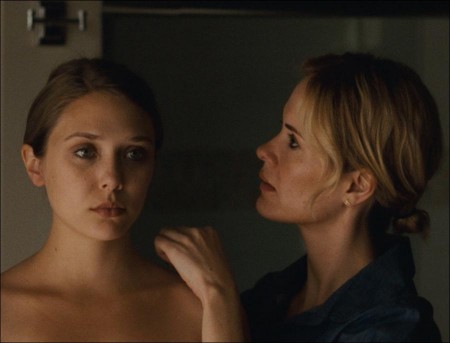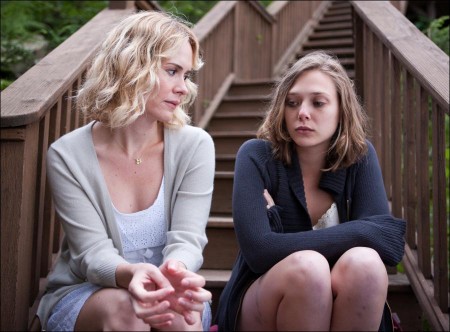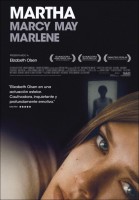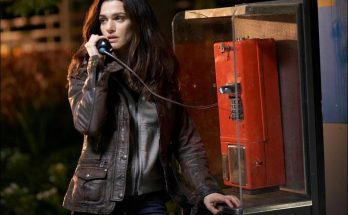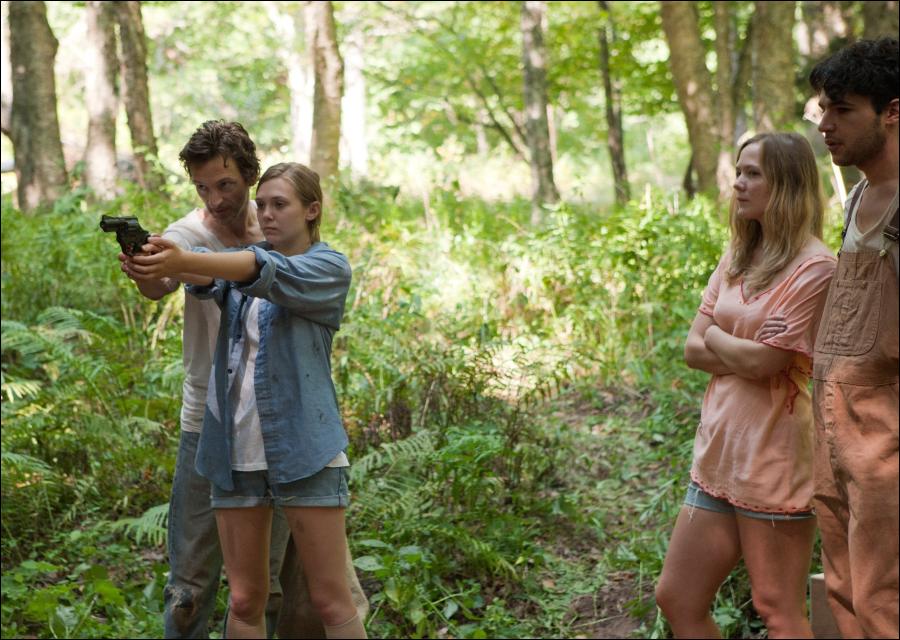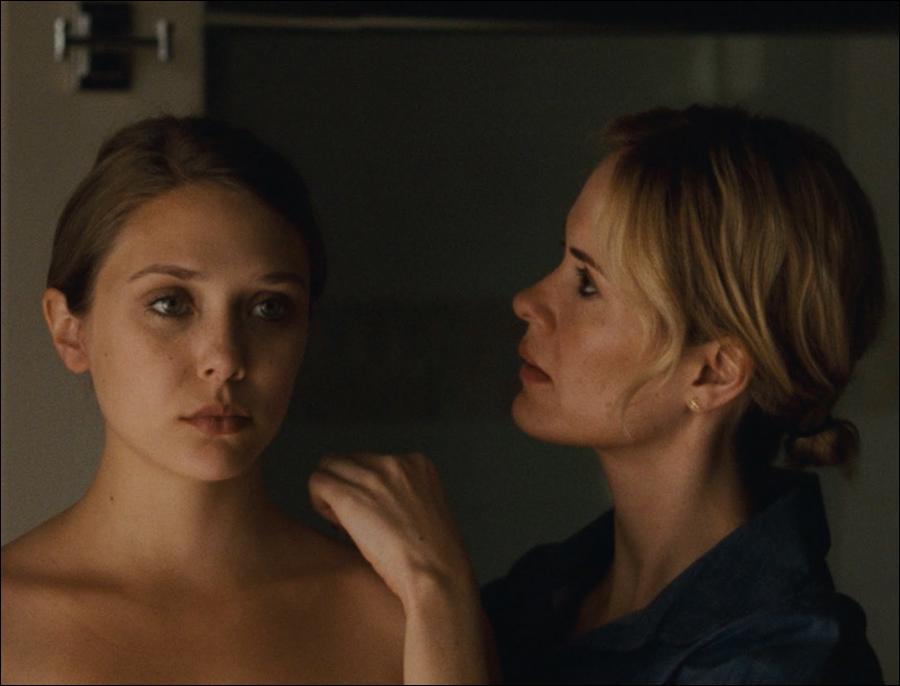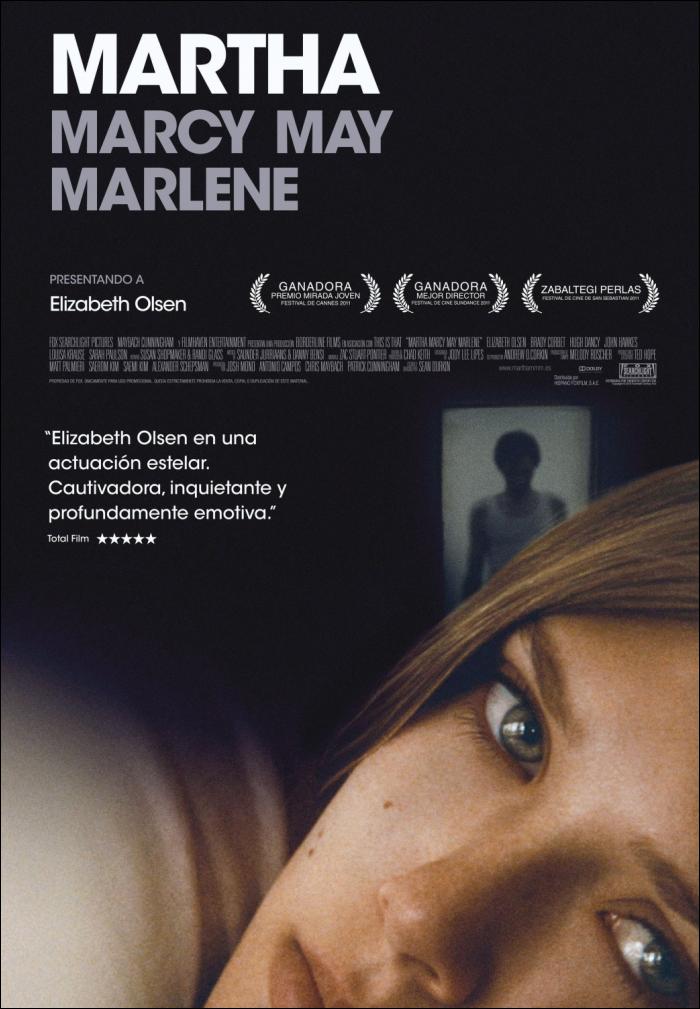Martha (Elizabeth Olsen) runs from an idyllic farmhouse into the woods of Upstate New York. Terrified, and with nowhere to turn, she calls the estranged sister she hasn’t seen in years (Sarah Paulson), and suddenly finds herself in a lush, lakeside Connecticut summerhouse with Lucy and her new husband Ted (Hugh Dancy). Yet, the beauty and comfort of Martha’s new surroundings clash with everything she is feeling as a secret fugitive from an unexplainable world, and so long away from society’s rules, she is unable to act in a way others find normal.
Martha may have run away, but she still is held captive by memories that slowly, devastatingly, begin to creep up on her. Seeping into her fledgling new life, revealing all that she has been through, from the innocent desire for familial love that brought her to a secluded farm commune to her chilling relationship with the fatherly but manipulative community leader Patrick (John Hawkes). Building, until they expose the heart-stopping source of her mounting dread.
Who Can You Trust When Nowhere Is Home?
Sean Durkin’s first feature film is an intimate journey into deep peril, as he and a fluid, probing camera follow a young woman who has run away from an idealistic but controlling cult on a secluded farm far from society’s reach. Finding refuge with her sister, she seems safe at last, but Martha is far from it, as secrets fester inside her, where everyday family life seems as strange as the world from which she has broken away and nowhere feels like home.
Durkin has long been fascinated by the power and lure of utopian, family-like cults in America. But with MARTHA MARCY MAY MARLENE he wanted to explore this topic that is usually presented in broad or sensationalized strokes from an original, personal perspective – from inside the pressure-cooker of emotions impacting a young girl trying to get away from a cult that has left her with questions about her place in society, her future and her own culpability.
“I wanted to do something character-based, contemporary and naturalistic,” explains Durkin. “I feel like cults are usually portrayed so that they’re over the top caricatures of themselves. So I started doing a lot of research and I read one passage that just completely popped out at me and said, ‘this is the story I want to tell.’ It was about a girl who left a group that was growing more and more violent. I wondered what the weeks after leaving were like for her? How does someone settle back into normal society after living through that?”
Durkin started talking about the fledgling story with his partners at Borderline Films, a thriving indie production company formed by Durkin, along with Josh Mond and Antonio Campos, when all three were students at NYU Film School. Since then, the collective has nurtured a growing group of collaborators — nearly all under the age of 30 — to explore every avenue of filmmaking, from writing and directing to producing and shooting. Their driving MO has been to give each other maximum creativity even amidst the industry’s shifting economics.
Mond and Campos made it clear right away they would do anything and everything to help Durkin realize his new idea. “The general theme of the way we work is that each of us is down to do whatever it takes for the others,” explains Mond. “Sean, Tony and I have built a deep trust in each other and that seeps through to everything we do at every level.”
Adds Campos, “We knew Sean was the right person to tell this story because he has so much sensitivity. He’s a classic filmmaker in a lot of ways. He really cares about finding the truth in the moment and that’s a rare thing. Another director could have made this film, but not with as much subtlety or power. We always maintained that belief in him, and our job from the beginning was to let Sean focus completely on what matters: the creative side of the film. With us, it’s not just about fighting for a filmmaker – it’s about fighting for a friend.”
As Durkin began writing, often bouncing ideas off of Campos and Mond, he found that the story hit even closer to home than he’d imagined. “A friend of mine came forward and said she’d been through something similar. She wanted to help me, and she’d never talked about it openly before. She shared her stories with me and they were very painful, scary and sad. She was very generous. From that came the basis of Martha’s story,” says Durkin.
His imagination sparked, Durkin started envisioning sharp, detailed pictures of the cult family Martha joins, with its back-to-the-land lifestyle and the alternative philosophies of its leader, Patrick. “The question for me was how do I make this real?” Durkin recalls. “A turning point came when I went up to the Catskills and I saw all these abandoned farms up there. I realized it would be so easy for someone to come up and start a community here and suddenly have 20 people living together on this farm. So that became the foundation for Patrick’s community.”
Durkin imbued Patrick with many of the contradictory qualities that make cult leaders so capable of attracting blind devotion including charisma, compassion for his followers, idealistic philosophies that stand in defiant opposition to a materialistic society and even a musical talent that lends him moments of easy charm despite his dark actions. But Durkin also made it clear how these same qualities have become subverted with the power Patrick holds, especially over young women.
He binds his community not only with ties of closeness, but with chains of violence, justifying himself every step of the way as a loving father to his flock. Patrick may see himself as a moral visionary, but Durkin reveals him transgressing past all ethical boundaries in the name of his beliefs.
“Some of what Patrick says comes out of real truths,” notes Durkin. “He talks about being in the moment, about focusing on other people, on the land, and what it means to all be together but then he manipulates all those attractive ideas to get what he wants.”
The key to Durkin’s script was its tone, which merges the snowballing fear of a horror thriller with the life-like naturalism of a drama stripped to the barest emotions. Though the story delves into worlds not often seen, Durkin notes that there are also aspects of Martha’s story that will be relatable to anyone who has ever felt they were trying to be two people at once. “Ultimately, it’s a story about identity,” he says. “At the farm, they’re always talking about ‘finding your role in the family,’ and I think that is a very basic part of human nature. We all want to belong, to be part of something, to feel like we contribute somehow to the group. No matter who you are, everybody takes on slightly different roles and personas for the various parts of their life. Like many people, Martha isn’t sure who she is anymore, but her situation is extreme.”
While Durkin was still writing the script for MARTHA MARCY MAY MARLENE, he decided he needed to prove himself as a first-time feature film director (he’d already produced several projects for Borderline Films), so he wrote and directed a short film that also emerged out of his research about cults. With Campos and Mond serving as producers, Durkin shot MARY LAST SEEN, starring Brady Corbet, for about $400 on credit cards in 2010. It went on to win the Cannes Director’s Fortnight Short Film Prize, becoming a catalyst for the next step.
“We sent the film to Sundance without thinking about it too much and simultaneously submitted the script for MARTHA MARCY MAY MARLENE to the Screenwriters Lab. Both got in, and that really changed things,” recalls Durkin. “The short was at Sundance and then went to Cannes, and while I was at the Writer’s Lab, Josh and Antonio were able to secure a little financing. I came home and went full steam ahead.”
Campos credits Mond with creating a lot of that propulsive steam that allowed them to make the film. “The chutzpah that Josh has as a producer is amazing,” he says. “It’s something special and it was a driving force in getting this film, and all our films, made.” Responds Mond, “I think a lot of people supported us because they connected with Sean’s script and believed in the project from the beginning. In the end, everyone who joined the production from the cast to the below-the-line crew trusted Sean’s vision and instincts.”
Martha AKA Marcy May AKA Marlene
The first major task facing the filmmakers was to cast the film’s central character, the young woman named Martha who becomes Marcy May (and sometimes Marlene) as a member of a cult family — and then becomes Martha again, in a courageous bid for a new life on her own. Casting director Susan Shopmaker, part of the Borderline Films’ circle of collaborators, surprised everyone when she suggested Elizabeth (Lizzie) Olsen, who had never made a movie before, for the role. To the filmmakers’ awe, Olsen proved ready to dive fearlessly into the darkest corners of a young girl’s mind as she confronts confusion, paranoia, shame and defiance, as she fights for her future.
When Sean Durkin saw Olsen audition for the first time, he knew he’d found exactly the right person to take this challenging journey. “Lizzie is so interesting to look at, so unique and beautiful. She has a depth to her, and an emotional strength. I just sensed it was all there when I first met her,” he remembers. “I could picture her walking down a driveway, picking up a rock, and shattering a window – as someone who could carry that boiled-up anger but also have the strength to let it fly.”
In turn, Olsen found the story riveting and believable, and right away felt she could intuit all that was going on underneath Martha’s skin, as her strange past bleeds into her present. “This is the first script I’ve read that got me really excited,” says Olsen. “It was something very different and I could see the character so clearly. I understood her psyche and in a weird way, I really liked Martha.”
She goes on, “I especially loved that Sean didn’t ever cede information to the audience. He treats the audience as intelligent and allows them to make discoveries as the characters do. I was also amazed that such a good script for a woman was written by a man. It’s a really cool, special thing. Martha is the type of character I hope more filmmakers will write for young women. She’s not a stereotype and her struggles are very real.”
Martha’s struggles began long ago in a troubled home life, which Olsen believes made her easily vulnerable to the appeal of a commune offering her the sense of family and meaning she’s been missing all her childhood. “At first, Martha thinks she’s found her sense of purpose in this family, which she’s never had her entire life,” says Olsen. “Patrick is the first person to ever make her feel truly loved and important. That’s what leads her to stay on the farm, but once she starts to question what is going on morally inside this family, that’s when problems start. She starts to wonder, just how far are they willing to go to be self-sufficient in this seemingly happy, pleasant place?”
It was clear to Olsen from the beginning why Martha was unwilling to tell her sister, or anyone else, about what she has been through. “She really feels like she can’t talk about it and she’s still living in a state of extreme paranoia, unable to trust anyone,” she explains. “Martha turns to Lucy only because she has nowhere else to go, but they don’t exactly have the closest relationship. Lucy has just gotten married and though she tries to help Martha blindly, it creates a lot of friction in the house.”
A lot of that friction stems from Martha’s inexplicable behavior. “She can’t really remember how she is supposed to act in society,” explains Olsen, “and she still believes in the cult way of living. She wants to be selfless and not materialistic, but those ideas have become twisted up in her mind. She doesn’t understand little things, like the way people sit down for dinner – she hasn’t sat down with another male in years, so she really can’t eat in front of a man. She doesn’t even know when it’s normal to be naked and when it’s not. She is a stranger in a strange land.”
Once on the set, Olsen developed a rapport with Durkin that was key to her ability to be so exposed in the role. “Sean is so caring and sensitive and no BS, that it was like being directed by a good friend,” she says. “You can share your secrets with him, because you know he’ll keep them. He was always answering my questions – and I asked a lot of them – and everything he said clicked.”
Olsen admits the darker sequences at the farm were frightening to her, but she dove in anyway. “I think Martha is completely devoid of any understanding of sexuality when she gets to the farm and what happens to her is scary for anyone to face,” she says. “It was a difficult thing to portray but I really trusted Sean aesthetically and he gave me all the space and time I needed.”
Josh Mond was impressed with how positive Olsen was able to stay under the circumstances. “She definitely had a lot of challenges,” he says, “but Lizzie has an infectious energy that kind of set the tone for everyone. Just watching her had the rest of us very excited.”
Adds Antonio Campos, “Lizzie was the biggest discovery of the film. We all watched her audition tape a million times and the consensus was that she had incredible potential. Of course, it’s always a bit of a gamble and you never really exactly how it will turn out, but we soon saw that no one works harder than Lizzie. She just didn’t stop getting better.”
Working with John Hawkes further gave Olsen the trust needed to go to some very perilous places, as Patrick “initiates” Marcy May into his forced version of shared intimacy with his family. “We were in a lot of compromising positions,” she says, “but I never felt uncomfortable with John until I was supposed to. He always made me feel like everything we were doing was safe.”
Safety throughout was essential, because Olsen spent much of the movie in a kind of naked state — emotionally and literally — often dirty, without makeup, clothes or even defenses. “The film is about raw human reactions, raw life,” she observes. “Nothing is manipulated.”
That was really the only way it could have worked, given that Martha’s story hinges on pulling the audience into her fear and uncertainty. “It’s funny because we had such a great time filming and it was great to play Martha… but I still find her life completely terrifying,” Olsen sums up.
On The Farm
To re-create Martha’s life on the farm, Sean Durkin knew he needed an actor who could evoke both the allure and savage impulses of the community leader Patrick. He had no doubt that John Hawkes, fresh off his Academy Award® nomination for the searing role of Uncle Teardrop in WINTER’S BONE opposite Jennifer Lawrence, could give the character the necessary human depth.
Hawkes says that working with Elizabeth Olsen reminded him a lot of the catalytic impact of watching Lawrence perform. “I got a pretty great idea early on that Lizzy was hitting it out of the ball park, a lot like Jennifer did on WINTER’S BONE,” he says. “They are both young women who are wise beyond their years, both very game and very brave.”
Indeed, Hawkes sees some elemental similarities between the two gritty, indie films, despite their very different subject matters, locales and styles. “What is interesting is that they both focus on a young woman in ways that we don’t usually get to see,” he says.
It was the unusual nature of the whole story that grabbed Hawkes from the beginning. “There are a lot of scripts about cults out there, but this one was very different,” he says. “It was only half about life in the community and the other half was about a young woman’s attempt to live in the world after escaping that. The writing had a lot of gray areas, a lot of tension and no easy answers. Once I spoke to Sean on the phone, he was so convincing and interesting that I took that leap of faith.”
Although Patrick shares personality characteristics with several infamous American cult leaders – from Charles Manson to Jim Jones to David Koresh — Hawkes did not want to emulate any of them. “I’m usually very much an over-preparer but in this particular case, I didn’t want to research a great deal. I didn’t want to pattern Patrick after any true-life character,” he explains. “I felt like my job was to make him a credible seducer but never too arch or over the top. I thought the more I could make him a real, caring, charismatic person, the more this guy would be someone Martha would want to follow and truly believe in. I tried to avoid the obvious. I wanted to play him as a decent human being because that makes the way things turn out much more interesting.”
Part of Patrick’s appeal is his ability to boost a young person’s self esteem, with just a nod of approval or warm, paternal smile. “I think a lot of manipulators are good at that,” observes Hawkes. “They find what a person lacks and try to feed it to them. Patrick is able to be just the kind of father figure that a young woman in distress would cleave to.”
Yet for all of his exploitation and moral degeneracy, Hawkes was able to find a drop of something genuine at Patrick’s core. “I’ve never played a character I didn’t like and I wouldn’t be able to,” he comments. “This is a difficult guy to like, but one of the exciting things about being an actor is finding moments with a guy like Patrick that the audience can side with. That was the challenge.”
Shooting in the Catskills, in a peaceful, rural setting that felt like its own private world, helped Hawkes to sense the moments that make the farm community seem to young newcomers like a more loving alternative to the harsh, outside world. “We were all kinds of marooned there and it truly felt like a family, like a real community, and that was great for the film,” he says.
In one riveting sequence, as true-to-life as it is unsettling, Hawkes portrays Patrick serenading his followers with a song for Martha. Having played music all his life, Hawkes was willing to tackle the intimate, campfire-style performance, improvising around a classic 60s folk tune by Jackson Franks called fittingly “Marlene.” “I wanted to serve the song the same way you serve the story in a film,” he explains. “We did it without edits, just me playing solo shot straight through, warts and all. It was very cold that day and part of the challenge was just trying not to let my teeth chatter!”
He goes on, “I felt like it was such a great song for the movie – it was mysterious and odd and psychedelic, yet it had a soft, lovely edge to it. I was worried about how that scene might go but it was real fun and exciting. It was almost like adding to the score in a way, and it provides some texture to Patrick, showing his positive side… and the more you can get that out there in the story, the better.”
The song brought home to Elizabeth Olsen why Hawkes was so right for the role. “If you had someone who was just creepy and scary, you wouldn’t believe they could entice all these people to come to the farm, but with John, there is something else, just a little edge,” she comments. “He can be such a kind person and when he sings Martha a love song, she falls for it. I’d fall for it, too.”
A rising young star who have become part of the Borderline Films family comes to the fore as a member of Martha’s cult family: Brady Corbet plays Watts, who recruits her into the unusual collective; and Christopher Abbott is Max, who grows close to Martha when she is Marcy May on the farm.
Corbet, who made his feature film debut in THIRTEEN, and is known for his role as Derek Huxley on the hit television series “24,” describes Watts as “a true believer who meets girls in the city and brings them to the farm.” He might have some deep-seated regrets over luring innocent kids into the controlling atmosphere of the community, but Corbet says he is beyond recognizing them. “Watts is too far gone at this point – it’s too late for him to save himself or to save anyone else,” he says.
Martha Marcy May Marlene
Directed by: T. Sean Durkin
Starring: Elizabeth Olsen, Hugh Dancy, John Hawkes, Sarah Paulson, Brady Corbet, Maria Dizzia, Julia Garner, Louisa Krause, Lauren Molina
Screenplay by: T. Sean Durkin
Production Design by: Chad Keith
Cinematography by: Jody Lee Lipes
Film Editing by: Zachary Stuart-Pontier
Costume Design by: David Tabbert
Art Direction by: Jonathan Guggenheim
Music by: Danny Bensi, Saunder Jurriaans
MPAA Rating: R for disturbing violent and sexual content, nudity and language.
Studio: Fox Searchlight Pictures
Release Date: October 21, 2011
Hits: 81

